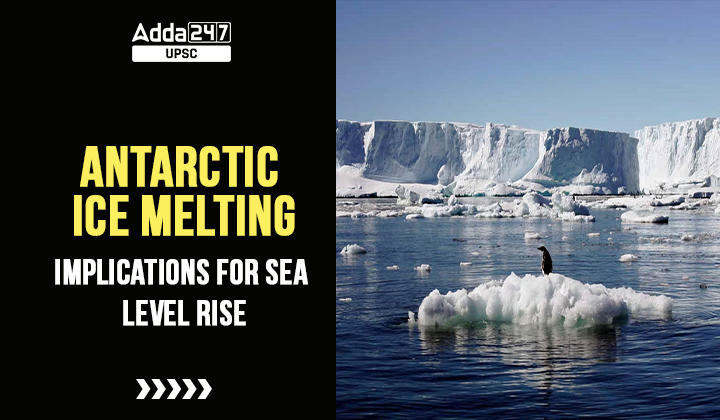Table of Contents
The ominous consequences of climate change are becoming increasingly evident as new scientific research emerges. A recent study has shed light on the worrying state of the West Antarctic ice sheet, revealing that the rate of ice melting will continue to increase at an alarming pace over the next century, regardless of our efforts to curb greenhouse gas emissions.
This finding has profound implications for global sea levels, coastal communities, and the urgent need for long-term adaptation strategies. In this article, we will explore the key findings of the study and delve into the implications for our planet, emphasizing the importance of sustained efforts to mitigate climate change and prepare for the inevitable rise in sea levels.
West Antarctic Ice Sheet Under Siege
- The West Antarctic Ice Sheet (WAIS) has long been recognized as a critical player in sea level rise. Comprising a vast expanse of ice, it has the potential to raise global sea levels by up to five meters. This makes it a substantial contributor to the ongoing climate crisis.
- Scientists have recently employed cutting-edge technology and simulations to determine the trajectory of ice melting in the WAIS. The results are deeply concerning, indicating that the thaw is unstoppable.
Inevitable Melting Despite Mitigation Efforts
- No matter how strenuously we reduce fossil fuel use and implement ambitious climate change mitigation measures, the West Antarctic ice sheet’s melting is set to accelerate.
- The study considered a spectrum of emission scenarios, from mid-range to the most optimistic targets of the 2015 Paris Agreement.
- Surprisingly, the outcome was the same – the ice melting will continue its rapid pace. Even in a best-case scenario where global temperature increases by only 1.5 degrees Celsius, the rate of ice melting will be three times faster than it was during the 20th century.
Ocean-Driven Melting and Warming of the Southern Ocean
- Understanding the factors driving this accelerated ice melt is crucial to grasping the severity of the situation. While various climate phenomena, such as El Niño, can influence the ice sheet’s dynamics, the primary culprit appears to be the warming of the Southern Ocean, particularly the Amundsen Sea region.
- This warming ocean interacts with the ice sheet, causing it to lose mass at an alarming rate.
The Role of Ocean Warming
- The Southern Ocean’s temperature rise is a direct result of climate change and is exacerbating the ice melt in West Antarctica.
- This warming water infiltrates beneath the ice shelves, accelerating their disintegration and causing massive ice loss.
- Scientists have observed this phenomenon as one of the most significant drivers of the Antarctic ice melt, making it a pressing concern for the global community.
Implications for Rising Sea Levels
- The relentless melting of the West Antarctic Ice Sheet has profound implications for global sea levels.
- With the potential to contribute several meters of sea level rise, it poses a direct threat to coastal communities, infrastructure, and ecosystems.
- As the study’s lead author aptly notes, recognizing this situation in advance is essential for preparing and adapting to the impending sea level rise.
Coastal Communities at Risk
- Millions of people around the world inhabit coastal regions, and they are in the crosshairs of the rising sea levels. As the ice continues to melt, these communities face the stark reality of losing their homes and livelihoods.
- The impact on these regions is not a matter of if but when, and the implications are severe.
The Urgent Need for Adaptation
- While the situation might seem bleak, it is essential not to succumb to despair. The study’s findings underscore the urgency of adapting to rising sea levels.
- With advance knowledge of this predicament, governments, communities, and scientists can work together to build resilient strategies, re-engineer vulnerable areas, and plan for evacuations if necessary.
Looking Ahead: A Call to Action
- The study’s findings are a stark reminder that climate change’s impacts are already locked in, and we must act swiftly to mitigate further damage.
- The ice melt in West Antarctica is a harbinger of a larger crisis, and it underscores the importance of reevaluating our efforts and refocusing our priorities.
Continuing the Fight Against Climate Change
The most critical message from this study is that we must not relent in our battle against climate change. While the West Antarctic ice sheet may be beyond our immediate control, we can still make a significant difference by reducing greenhouse gas emissions and slowing the rate of global warming.
Preparing for the Inevitable
- Recognizing the inevitability of sea level rise is a vital step in preparing for the future. Governments worldwide should prioritize long-term planning for the re-engineering of coastal areas and, when necessary, evacuation strategies.
- A fifty-year lead time can make all the difference in safeguarding communities and minimizing the impact of rising sea levels.
Conclusion
- The findings of the recent study on the accelerating ice melt in West Antarctica are a wake-up call to the world. They serve as a stark reminder of the urgency of our fight against climate change and the necessity of preparing for the inevitable consequences of sea level rise.
- As the West Antarctic Ice Sheet continues to shed its mass into the ocean, we must redouble our efforts to reduce greenhouse gas emissions, adapt to rising sea levels, and protect the millions of lives and livelihoods at stake along the world’s coastlines.
- The time to act is now, for the future of our planet and its inhabitants depends on our determination and resilience in the face of this unprecedented challenge.



 TSPSC Group 1 Question Paper 2024, Downl...
TSPSC Group 1 Question Paper 2024, Downl...
 TSPSC Group 1 Answer key 2024 Out, Downl...
TSPSC Group 1 Answer key 2024 Out, Downl...
 UPSC Prelims 2024 Question Paper, Downlo...
UPSC Prelims 2024 Question Paper, Downlo...
